Add your promotional text...
Samsung Galaxy S21 (2021) Review : A Game-Changer in Smartphone Technology
The Samsung Galaxy S21 (2021) delivers strong performance, a vibrant 120Hz display, and a versatile camera setup. However, its plastic back and lack of expandable storage are notable drawbacks. It’s a great option for those seeking flagship features in a compact design.
SAMSUNG
12/14/202426 min read
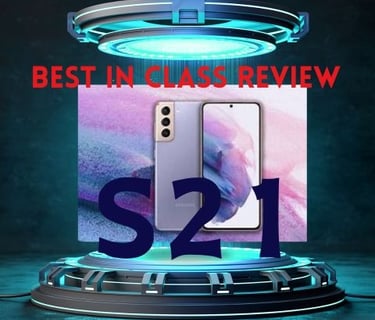

S21News
Click the button below to read our news article.
Samsung Galaxy S21 Review
What You Need to Know Before Buying the Samsung Galaxy S21
Introduction
The Samsung Galaxy S21, launched in early 2021, marks a bold evolution of the brand’s flagship series, bringing refined design, cutting-edge performance, and notable sacrifices to the forefront. While it retains the signature 6.2-inch FHD+ Dynamic AMOLED 2X display with a 120Hz adaptive refresh rate, which offers buttery-smooth scrolling and a visually immersive experience, the S21’s display is notably optimized for both color accuracy and power efficiency. This means users get an exceptional visual experience with vibrant, deep contrasts while maintaining fluid performance, whether it’s for media consumption, gaming, or productivity. The 120Hz refresh rate intelligently adapts based on the content being displayed, offering smoother interactions without overburdening the battery, a balanced approach compared to its predecessor.
Under the hood, the Galaxy S21 is powered by the Exynos 2100 (or Snapdragon 888 in select regions), built on a 5nm architecture that delivers significant gains in processing power and efficiency. With 8GB of RAM and 128GB or 256GB of internal storage (unfortunately non-expandable), the S21 delivers snappy performance across the board, from multitasking to gaming at the highest settings. The device also supports 5G connectivity, ensuring future-proofing in an increasingly connected world, with super-fast download speeds for users in compatible regions.
The camera system is another highlight of the Galaxy S21, featuring a 12MP wide sensor, a 12MP ultra-wide lens, and a 64MP telephoto lens with 3x hybrid zoom. The result is a versatile array of photographic options, from ultra-wide landscape shots to detailed telephoto close-ups. While the 64MP telephoto sensor offers excellent 3x optical zoom performance, the lack of a dedicated periscope lens means that its zooming capabilities fall short in comparison to the more advanced S21 Ultra. That said, the S21 still excels in everyday photography with its improved night mode, vibrant color reproduction, and powerful 8K video recording capabilities, which have redefined mobile videography.
However, Samsung made a few notable trade-offs in the S21, primarily to drive its pricing lower than its predecessor. The most significant of these is the switch from a glass back to a plastic rear panel, which, while still premium in feel, lacks the luxurious quality that many premium flagship users expect. This decision, though helping to reduce weight and enhance durability, does make the S21 feel slightly less refined when compared to its glass-bodied competitors. Another drawback is the absence of a microSD card slot, a feature once beloved by Galaxy fans for expandable storage. This exclusion, alongside the phone's non-removable battery, limits storage flexibility, a notable inconvenience in a world where apps, games, and multimedia files are growing ever larger.
Battery life, while improved with adaptive power management, remains a key point of contention. The 4000mAh battery provides a full day of use under moderate conditions, but power-hungry tasks like 120Hz gaming, video streaming, and 5G use can lead to quicker drain, making it essential for users to charge throughout the day if using these features regularly. Additionally, Samsung’s decision to exclude a charger from the box, a controversial move in an industry that's trending towards sustainability, means users must either use an existing charger or purchase one separately.
In conclusion, the Samsung Galaxy S21 is a powerhouse in terms of performance, offering impressive specs, camera capabilities, and an unparalleled display. Yet, its design choices, such as the plastic back and removal of certain features like expandable storage, do raise questions for those who expect a more premium, versatile experience from a flagship device. For users looking for a more affordable alternative to the S21 Ultra without sacrificing core features, the Galaxy S21 stands as a powerful, albeit slightly imperfect, option in the premium smartphone space. Its balanced blend of high-end performance, great display quality, and strong camera setup make it an excellent choice for most users, but the lack of key features and battery limitations could be a dealbreaker for others.
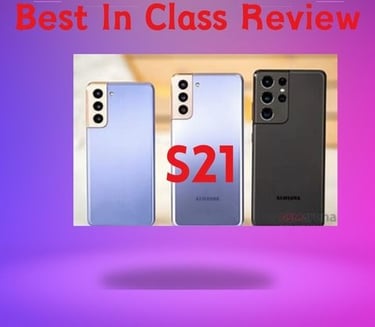

Key Features
Top Features, Performance, and Value Explained
The Samsung Galaxy S21, released in January 2021, quickly became a fan favorite thanks to its impressive combination of performance, design, and innovative features. Let’s take a closer look at some of the key features that make the Galaxy S21 a standout device.
1. Sleek and Modern Design
The Galaxy S21’s design is striking, with its minimalistic yet sophisticated look. The device features a 6.2-inch Dynamic AMOLED 2X display that offers vibrant colors and deep blacks, ensuring a stunning visual experience. The screen is flat, not curved, which some users prefer for better grip and durability. The Infinity-O display houses a punch-hole camera at the top center for a nearly bezel-less view. The phone comes in a range of attractive colors like Phantom Violet, Phantom Gray, Phantom Pink, and Phantom White, allowing you to pick the one that suits your style.
2. Stunning Display and Refresh Rate
The Galaxy S21’s 120Hz refresh rate ensures smooth scrolling, seamless transitions, and an overall enhanced viewing experience. Whether you're gaming, watching videos, or browsing, the fast refresh rate makes a noticeable difference. The Dynamic AMOLED 2X technology ensures the screen is energy-efficient, providing vibrant colors and sharp resolution while consuming less power. The FHD+ resolution delivers crystal-clear content, perfect for streaming movies or gaming on the go.
3. Performance and Speed
Under the hood, the Galaxy S21 is powered by the Exynos 2100 (for international versions) or the Qualcomm Snapdragon 888 (for U.S. models), offering lightning-fast processing and outstanding multitasking performance. With 8GB of RAM and storage options of 128GB or 256GB, you can store your apps, games, photos, and videos without worrying about running out of space. The phone can handle everything from resource-intensive apps to heavy multitasking without breaking a sweat, making it a great option for both casual users and power users.
4. Camera System
Samsung’s camera technology has been a key selling point for its Galaxy S series, and the Galaxy S21 doesn’t disappoint. The phone features a triple-camera system on the back, including:
12MP Ultra-Wide Camera: Captures a broader scene with vivid colors and high detail, ideal for landscapes and group photos.
12MP Wide Camera: The main shooter with a large sensor for great low-light performance and crisp images.
64MP Telephoto Camera: Offers a 3x hybrid optical zoom and up to 30x Space Zoom, allowing you to zoom in on distant subjects with impressive clarity.
The night mode and Super Steady Video features also ensure that your photos and videos look great, even in low-light conditions. The 8K video recording is another standout feature, enabling you to capture videos in ultra-high definition, ideal for sharing or preserving precious memories.
5. Battery Life
The Galaxy S21 comes equipped with a 4000mAh battery, which is good for a full day of use with moderate to heavy tasks. Thanks to power-efficient components like the Dynamic AMOLED 2X display and the Exynos 2100/Snapdragon 888 chipset, the phone can easily get you through a busy day. Additionally, it supports 25W fast charging, meaning you can get hours of battery life from just a short charging session.
6. 5G Connectivity
The Galaxy S21 is 5G-ready, meaning it can take full advantage of the latest high-speed data networks where available. Whether you're streaming content, playing games online, or downloading large files, 5G connectivity ensures you’ll have faster download speeds and lower latency.
7. One UI and Software Experience
Samsung’s One UI provides a clean and user-friendly interface on top of Android 11, making it easy to navigate and customize your device. The software features are packed with useful tools like Edge Panels, Samsung DeX (for desktop-like experiences), and Samsung Knox for added security. The Software updates for up to 3 years ensures that your device stays up-to-date with the latest features and security patches.
8. Under-Display Fingerprint Scanner
The Galaxy S21 uses an ultrasonic fingerprint scanner embedded under the display. This technology offers faster and more secure biometric unlocking, as it scans the unique patterns in your finger’s skin using sound waves. The sensor is quick and accurate, so you can unlock your phone effortlessly.
9. IP68 Water and Dust Resistance
One of the perks of the S21 is its IP68 rating, meaning it’s water and dust-resistant. This feature ensures that your phone can survive being submerged in water up to 1.5 meters for 30 minutes without any damage, making it perfect for everyday use, whether you’re caught in the rain or near a pool.
10. No Charging Adapter in the Box
While not necessarily a "feature" that everyone will love, the Galaxy S21 does not come with a charging brick in the box. This is a part of Samsung’s move toward a more eco-friendly approach. However, the phone still supports fast charging with compatible adapters and wireless charging, so you can easily find an alternative charging solution.
11. Affordable Flagship Experience
Although the S21 has many flagship features, Samsung made it more affordable compared to its predecessors by offering a more compact design and slightly trimmed-back hardware options, such as a plastic back. However, the reduction in price doesn’t mean a compromise in quality or performance. It’s a great option for anyone who wants top-tier features without breaking the bank.
Final Thoughts
The Samsung Galaxy S21 offers an excellent blend of performance, design, and features, making it a great choice for anyone looking for a premium smartphone experience without paying top-tier prices. Whether you’re a content creator, gamer, or someone who simply wants a reliable device, the Galaxy S21 provides everything you need to stay connected, productive, and entertained.
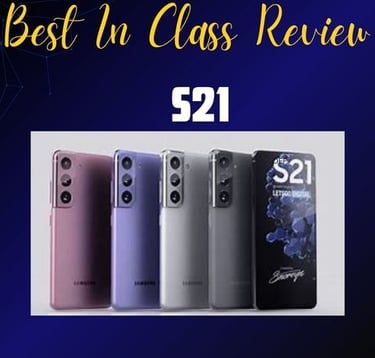

Key Features Table
Flagship Features at an Affordable Price
Performance Analysis
Why the Samsung Galaxy S21 Stands Out Among Premium Smartphones
The Samsung Galaxy S21 offers a robust and efficient performance profile, powered by the Exynos 2100 (global) or Snapdragon 888 (U.S.) chipset, both of which are built on a 5nm architecture for improved energy efficiency and enhanced processing power. While both variants deliver exceptional performance, the Snapdragon 888 tends to outperform the Exynos 2100 in terms of GPU performance and heat management. The Snapdragon 888's Adreno 660 GPU is notably more efficient, providing smoother graphics rendering, especially in graphically demanding games and high-performance applications. In contrast, the Exynos variant, while capable, may struggle slightly with sustained heavy workloads, as it tends to heat up faster, leading to potential thermal throttling during extended gaming or resource-intensive tasks.
The 8GB of RAM in the Galaxy S21 ensures smooth multitasking, with the phone easily handling a combination of apps, games, and media without noticeable slowdowns. Apps load quickly, and switching between tasks feels almost instantaneous. The 120Hz Dynamic AMOLED 2X display further enhances the performance experience, providing a fluid and responsive touch interface. The high refresh rate makes scrolling, animations, and gameplay feel incredibly smooth, with minimal motion blur. The FHD+ resolution ensures crisp visuals that are sharp and clear, contributing to a premium feel during media consumption.
When it comes to gaming performance, the S21 handles most titles with ease. Popular mobile games like PUBG Mobile and Genshin Impact run smoothly at high settings, though, under prolonged gaming sessions, the Exynos 2100 may experience more noticeable heat build-up, leading to a slight dip in performance compared to the Snapdragon 888 variant. This thermal limitation is less of an issue with day-to-day tasks but can affect sustained high-performance scenarios.
The internal storage options (128GB and 256GB) are fast and provide ample space for most users, but the lack of an expandable storage option can be a limiting factor for power users or those who store large amounts of data locally, such as 4K videos or extensive media libraries. Moreover, the absence of a microSD card slot could push those looking for flexibility in storage management toward other devices that offer expandability.
In terms of battery performance, the Galaxy S21 comes with a 4000mAh battery, which is sufficient for a full day of moderate use, including social media, video streaming, and web browsing. However, under heavy usage—especially with high screen brightness and demanding apps—the battery may require a midday top-up. The 25W fast charging capability provides a quick recharge, while wireless charging and PowerShare offer convenient alternatives for charging accessories or other devices.
Overall, the performance of the Galaxy S21 is stellar for most use cases, excelling in everyday tasks, gaming, and media consumption. The key performance strengths lie in its fast processing speeds, fluid display, and efficient multitasking capabilities. However, users who demand the highest level of gaming performance or those who need significant storage flexibility may find the Exynos variant's thermal performance and lack of expandable storage to be slight drawbacks in an otherwise outstanding device.
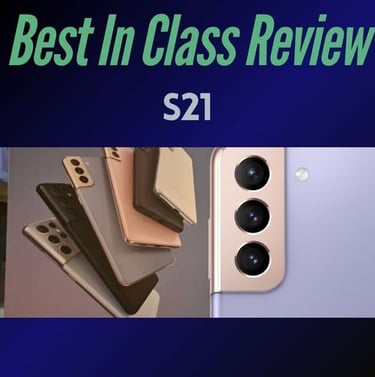

Market Positioning
Is It Still a Top Contender in 2024?
The Samsung Galaxy S21 (2021) was positioned as a flagship smartphone with a focus on high-end performance and design, targeting tech-savvy consumers and premium users. It was priced competitively in the upper mid-range to flagship segment, offering a balance between top-tier features and value, making it accessible to a broader audience compared to its Ultra counterparts. One of its core strengths in market positioning was its combination of cutting-edge specifications, such as the 120Hz Dynamic AMOLED 2X display, the powerful Exynos 2100 or Snapdragon 888 chipset, and a versatile triple-camera system, making it an attractive choice for consumers seeking a premium experience without the Ultra's higher price tag. Samsung also emphasized its 5G capabilities, IP68 water resistance, and all-day battery life, positioning the S21 as a device ready for the future of connectivity and multimedia consumption.
However, the S21's market positioning had some weaknesses. The decision to exclude certain features like a microSD card slot and a charger in the box, which were standard in previous models, was met with criticism from consumers who valued these as important additions. Additionally, while the S21's performance was top-notch, it lacked some of the premium features found in the Galaxy S21 Ultra, such as a higher-resolution display and more advanced camera systems. This could have made the device feel slightly underwhelming for users seeking the absolute best in every category. Furthermore, the higher price compared to competitors like the OnePlus 9 and Google Pixel 6 made it less appealing for cost-conscious buyers, despite its premium branding. Overall, the Galaxy S21 succeeded in attracting customers looking for flagship-level performance, but its positioning was slightly weakened by the exclusion of certain features and the premium price in an increasingly competitive market.
Prons and Cons
How It Stacks Up Against the Best in Class
Samsung Galaxy S21 Review: Detailed Pros and Cons
Samsung’s Galaxy S21 was released with high expectations, continuing the brand's legacy as a leader in the smartphone market. Positioned as a flagship device with top-tier specs at a competitive price point, the Galaxy S21 represents a powerful combination of performance, design, and innovation. However, like any device, it’s not without its trade-offs. Here’s an in-depth review of the Samsung Galaxy S21, breaking down its pros and cons to help you decide if it’s the right phone for you.
Pros of the Samsung Galaxy S21
1. Exceptional Display
Samsung continues its tradition of delivering outstanding displays, and the Galaxy S21 is no exception. The 6.2-inch Dynamic AMOLED 2X display is vibrant, crisp, and has a 120Hz refresh rate for a smooth, responsive experience. Whether you’re watching movies, gaming, or browsing, the colors are punchy and true-to-life, and the 1080p resolution offers excellent clarity. The screen also gets bright enough for outdoor use, making it easy to see content even in direct sunlight.
2. Top-Tier Performance
The Galaxy S21 is powered by the Exynos 2100 (for international models) or the Snapdragon 888 (for U.S. models), both of which are industry-leading processors. Whether you're multitasking, gaming, or running resource-heavy apps, the S21 offers seamless performance. Its 8GB of RAM ensures smooth app switching, and the overall fluidity of the system is remarkable. It’s one of the most powerful smartphones on the market and excels in demanding scenarios.
3. Excellent Camera Capabilities
Samsung has once again set a high bar for smartphone photography. The Galaxy S21 features a triple-camera setup, including a 12MP wide-angle sensor, a 64MP telephoto lens, and a 12MP ultra-wide camera. This combination allows for stunning versatility, with sharp, detailed images across all focal lengths. The 64MP telephoto camera offers a solid 3x hybrid zoom, and the night mode is excellent, providing clear, bright images even in low-light conditions. The 8K video recording feature is a nice touch, offering cinematic-quality footage. The camera software is intuitive, and there are plenty of shooting modes to experiment with, from portrait shots to slow-motion video.
4. 5G Connectivity
The Galaxy S21 comes with 5G support, which is becoming increasingly important as next-gen networks roll out. The phone supports both sub-6GHz and mmWave 5G, offering blazing-fast download and upload speeds when connected to compatible networks. As 5G becomes more widespread, the S21 is future-proofed for the next wave of mobile connectivity.
5. Sleek and Premium Design
Samsung’s design language continues to impress with the S21. The phone has a sleek, modern look, with an aluminum frame and a plastic rear cover that, while not as premium as glass, still feels solid and durable. The rear camera module has a seamless integration into the body, giving the phone a polished, refined appearance. The device is available in a range of attractive colors, ensuring there’s a style for everyone. Despite the plastic back, the S21 feels lightweight and comfortable in hand, making it easy to use one-handed.
6. Strong Ecosystem Integration
One of the advantages of the Galaxy S21 is its seamless integration with Samsung’s broader ecosystem, including wearables like the Galaxy Watch, tablets, and smart home devices. Features like Samsung DeX, which turns your phone into a desktop-like experience, make the S21 more versatile for power users. Samsung's SmartThings platform also ensures your Galaxy S21 connects effortlessly to your smart home devices.
7. Great Value for a Flagship
Compared to other flagship phones like the iPhone 12 or Google Pixel 6, the Galaxy S21 is priced relatively competitively. While still premium, Samsung has managed to keep the price lower than some of its key rivals, providing great value for users seeking a top-tier smartphone experience without paying top-tier prices.
Cons of the Samsung Galaxy S21
1. No MicroSD Card Slot
One of the most notable omissions in the Galaxy S21 is the removal of the microSD card slot. For users who value expandable storage, this is a significant drawback. While the base model offers 128GB of storage, power users who store large amounts of media, apps, or files may find themselves needing more. The lack of expandable storage is a move toward streamlining the device, but it could alienate users who are accustomed to the flexibility Samsung’s previous phones provided.
2. Plastic Back Panel
While the plastic rear panel of the S21 helps reduce costs and makes the phone lighter, it does feel a bit less premium compared to the glass backs found on its predecessors, like the Galaxy S20. Some users may feel that this choice undermines the overall luxury feel of the phone, especially at its price point. However, the plastic does offer more durability, reducing the likelihood of cracking if dropped, which is a trade-off worth considering.
3. No Headphone Jack
Another drawback for some users is the lack of a 3.5mm headphone jack. While Samsung had already started phasing this out with previous models, its absence in the S21 might still be a deal-breaker for audiophiles or anyone who prefers using wired headphones. The solution for this, of course, is wireless headphones or using a USB-C-to-headphone adapter, but this still feels like a step backward for some.
4. No Charger in the Box
Following a trend set by Apple, Samsung has also chosen to remove the charger from the box. This means that you’ll have to buy one separately if you don’t already have a compatible USB-C charger. While this decision is meant to reduce e-waste, it’s still a downside for users who were expecting a complete out-of-the-box experience.
5. Average Battery Life
While the 4,000mAh battery is adequate for a full day of moderate use, the Galaxy S21’s battery life may not be as long-lasting as some of its competitors, particularly those with larger batteries or more power-efficient processors. If you’re a heavy user, you may find yourself reaching for the charger earlier than expected, especially with the 120Hz refresh rate enabled. Battery optimization could have been better, especially considering the phone's price.
6. Limited Design Choices
While the Galaxy S21 has an attractive design, it does not offer as much customization as some of its competitors. For example, there are fewer premium materials used compared to the S21 Ultra, which features a glass back. Additionally, although the phone is available in multiple colors, the design is somewhat conservative and may not stand out as much compared to more radical designs from other brands.
7. Limited Zoom Capabilities
Although the S21 has a solid 3x hybrid zoom, it falls behind in terms of zoom performance compared to the S21 Ultra or even the iPhone 12 Pro Max. The lack of optical zoom beyond 3x may limit users who prioritize long-range photography. While the digital zoom can go up to 30x, the quality at higher zoom levels isn’t comparable to that of more expensive devices in the market.
In summary, The Samsung Galaxy S21 is a fantastic flagship smartphone that delivers on its promise of high-end performance, camera quality, and display brilliance at a competitive price point. Its sleek design, powerful specs, and seamless integration into Samsung’s broader ecosystem make it a solid choice for many users. However, the lack of expandable storage, the plastic back, and the removal of the headphone jack might be deal-breakers for some. For those looking for cutting-edge technology at a slightly lower price than its competitors, the Galaxy S21 is an excellent option, though it may not be the perfect fit for everyone. Ultimately, its strengths far outweigh its weaknesses, but whether it's the right choice depends on your specific needs and preferences.
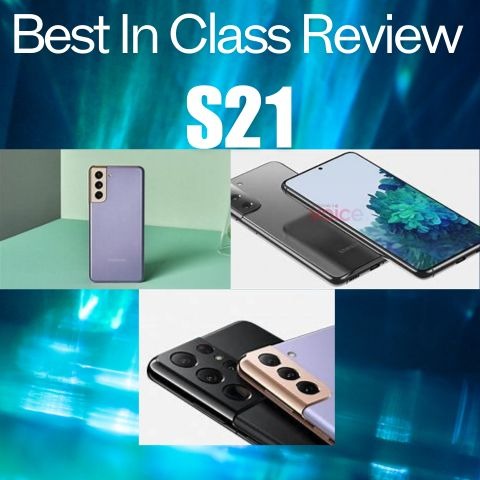

Comparative Analysis
Best Features, Pricing, and Competitors Analyzed
Comparative Analysis: Samsung Galaxy S21 vs Key Competitors
The Samsung Galaxy S21 is one of the most highly anticipated flagship smartphones of 2021, competing with other top-tier devices like the Apple iPhone 12, Google Pixel 6, and OnePlus 9. Each of these phones brings unique strengths to the table, appealing to different segments of consumers based on features, performance, and brand preference. In this analysis, we will compare the Samsung Galaxy S21 with its key competitors across several critical aspects, including design, display, performance, camera capabilities, and pricing.
Key Competitors Overview
Apple iPhone 12
Apple’s iPhone 12 series continues its dominance in the premium smartphone market with a blend of design, performance, and ecosystem integration. The iPhone 12 has a premium ceramic shield front, a 5G-capable A14 Bionic chip, and powerful cameras optimized with Apple’s computational photography.
Google Pixel 6
Google’s Pixel 6 brings the latest Android experience with the custom-built Google Tensor SoC. Known for its software-first approach, the Pixel 6 emphasizes AI-powered features and excellent camera performance, making it a strong contender for users who prioritize Google’s services and software integration.
OnePlus 9
The OnePlus 9 offers flagship-level specs at a slightly lower price compared to the Galaxy S21 and iPhone 12. With a 120Hz AMOLED display, Snapdragon 888 chip, and Hasselblad partnership for enhanced camera performance, it provides a solid all-around package for users who want flagship performance without paying top-tier prices.
Strengths and Weaknesses Comparison
Samsung Galaxy S21:
Strengths:
Display: The Dynamic AMOLED 2X screen offers vibrant colors, high contrast, and a smooth 120Hz refresh rate.
Performance: Powered by either the Exynos 2100 or Snapdragon 888 chipset, the S21 delivers excellent performance for multitasking, gaming, and heavy app usage.
Camera: With versatile triple-camera setups, the S21 excels in producing sharp, detailed images with great low-light performance and impressive video capabilities, including 8K recording.
Ecosystem: Seamless integration with Samsung’s broader ecosystem, including wearables, tablets, and smart home devices, enhances the overall experience.
Value: Compared to its direct rivals like the iPhone 12 and iPhone 13 Pro, the S21 offers a slightly more affordable price while still delivering flagship features.
Weaknesses:
Plastic Back: The decision to use plastic for the rear panel makes the phone feel less premium compared to glass-bodied rivals, which might be a turnoff for some.
No MicroSD Slot: The removal of expandable storage limits flexibility for users who require extra space for media and apps.
Battery Life: The 4,000mAh battery, although decent, may not be enough for heavy users, especially considering the power demands of the 120Hz display.
No Headphone Jack: The absence of a headphone jack may alienate users who still prefer wired audio connections.
Apple iPhone 12:
Strengths:
Performance: The A14 Bionic chip is one of the fastest processors on the market, delivering unmatched performance for apps, gaming, and computational tasks.
Display: The Super Retina XDR OLED display provides deep blacks and exceptional color accuracy.
Ecosystem: iOS and the broader Apple ecosystem (AirPods, Apple Watch, Mac, etc.) make the iPhone 12 highly attractive to users who are already embedded in Apple’s world.
Build Quality: The iPhone 12’s Ceramic Shield and glass back give it a premium, durable feel.
Weaknesses:
Price: The iPhone 12 is priced similarly to the Galaxy S21, but for the same price, it lacks some premium features like a 120Hz display and higher-quality cameras.
Camera Flexibility: While the iPhone 12’s camera performs well in standard conditions, it lacks the versatility offered by Samsung’s higher-end telephoto lenses or the Pixel’s AI-driven features.
Battery Life: The 2,815mAh battery, though optimized by iOS, lags behind some competitors in longevity, especially when paired with the 5G connectivity and demanding tasks.
Google Pixel 6:
Strengths:
Camera: Google’s computational photography, powered by the Tensor chip, provides superior software processing, making the Pixel 6 one of the best for low-light and portrait shots.
Android Experience: The Pixel 6 runs pure Android, giving users a clean and bloat-free interface with timely software updates and features like Google Assistant integration.
Software Features: Exclusive features like Live Translate and Magic Eraser make the Pixel a great choice for users invested in Google’s services.
Weaknesses:
Performance: While the Google Tensor chip is powerful, it doesn’t quite match the raw performance of the Snapdragon 888 or A14 Bionic chip, especially in gaming and heavy multitasking.
Build Quality: The Pixel 6’s plastic body and somewhat less refined design compared to Samsung and Apple devices might feel less premium.
Battery Life: While the Pixel 6 offers a large 4,614mAh battery, its power efficiency isn't as well-optimized as that of the iPhone 12 or Galaxy S21, leading to mixed battery life results.
OnePlus 9:
Strengths:
Performance: The Snapdragon 888 ensures top-tier performance, delivering smooth multitasking and gaming experiences.
Display: The 120Hz AMOLED display is vibrant, smooth, and great for media consumption and gaming.
Charging: OnePlus’s Warp Charge 65 offers incredibly fast charging speeds (65W), allowing the device to charge from 0 to 100% in just about 30 minutes.
Weaknesses:
Camera: While the Hasselblad partnership has improved the camera performance, it still lags behind the likes of the Galaxy S21 in terms of overall quality, especially in low-light and telephoto capabilities.
OxygenOS: While OxygenOS is one of the best Android skins, it’s not quite as refined or optimized as Samsung’s One UI or Google’s stock Android.
Brand Perception: OnePlus is still building its premium brand image, and while it offers great value, it doesn’t carry the same high-end prestige as Samsung or Apple in the eyes of many consumers.
In Summary, In the premium smartphone market, the Samsung Galaxy S21 stands as one of the most well-rounded options. It offers a combination of top-tier performance, a stunning display, and an impressive camera setup at a competitive price point. However, when compared to its key competitors—the iPhone 12, Google Pixel 6, and OnePlus 9—each has its own set of strengths and weaknesses:
The iPhone 12 offers unmatched performance, seamless integration with the Apple ecosystem, and superior build quality, but it lacks some of the display and camera versatility of the Galaxy S21.
The Google Pixel 6 is a standout for users who prioritize camera performance, especially with Google's AI-powered features, but its performance and build quality don't quite match the Galaxy S21.
The OnePlus 9 is a fantastic value proposition with its powerful hardware, fast charging, and solid display, but its camera performance still lags behind the S21 and iPhone 12.
Ultimately, the Samsung Galaxy S21 is an excellent all-rounder with a strong feature set, appealing to consumers who want a flagship device at a slightly more affordable price than its direct competitors. However, depending on your priorities—whether it's camera quality, battery life, or software experience—other devices like the iPhone 12 or Google Pixel 6 might appeal more to specific needs.
Features Comparison Table
How It Compares to Premium Flagships in 2024 (iPhone, Pixel, and OnePlus)
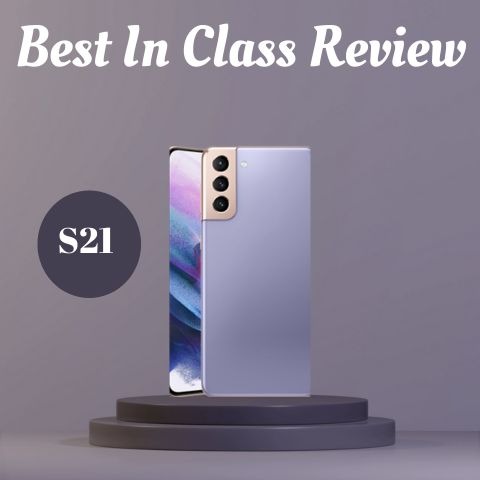

User Experience
Revolutionized the Smartphone Experience
The user experience on the Samsung Galaxy S21 is crafted to be both seamless and refined, blending cutting-edge hardware with a user-friendly interface that enhances daily interactions. The 6.2-inch Dynamic AMOLED 2X display is truly a highlight, delivering exceptional color accuracy, deep blacks, and remarkable brightness levels, making it a joy to view content both indoors and under direct sunlight. The 120Hz adaptive refresh rate offers an incredibly smooth experience while scrolling, gaming, or navigating through apps, and it dynamically adjusts between 48Hz to 120Hz based on the activity, optimizing battery life without compromising visual quality. Samsung’s One UI, built on Android 11, enhances the overall experience with a clean, minimalistic design that’s highly customizable. The one-handed mode, redesigned iconography, and intuitive settings allow users to personalize their interactions to fit their unique preferences, while features like Edge Panels and App Pairs offer enhanced multitasking for power users.
Performance-wise, the Galaxy S21 delivers a high level of responsiveness, powered by either the Exynos 2100 or Snapdragon 888 chipset (depending on the region). These processors handle even the most demanding tasks—such as high-end gaming, intensive multitasking, and video editing—with ease. Coupled with 8GB of RAM, the phone ensures smooth transitions between apps, quick loading times, and minimal app crashes, making it an excellent device for both work and play. Furthermore, Samsung’s excellent thermal management system ensures that the device remains cool even during extended gaming sessions or heavy usage, maintaining consistent performance.
In terms of photography, the Galaxy S21 excels with its versatile triple-camera array, which includes a 12MP wide sensor, a 64MP telephoto lens, and a 12MP ultra-wide camera. The software behind the camera system elevates the user experience by allowing for deep customization and flexibility. The camera app is well-organized, with features like Night Mode, Super Steady video, Single Take mode, and Pro Mode, making it easy for both beginners and more experienced photographers to capture stunning photos. The camera system handles low-light conditions remarkably well, with impressive noise reduction and sharpness even in near-dark environments. Furthermore, the 8K video recording capability is an intriguing feature for users seeking a more cinematic video capture experience, though it’s most beneficial when paired with a stable tripod or gimbal.
Battery life, while not as remarkable as some larger devices, is more than sufficient for a full day of use under moderate to heavy conditions. The 4,000mAh battery supports 25W fast charging, providing around 50% charge in just 30 minutes, ensuring that users aren’t left tethered to a charger for long periods. Additionally, wireless charging and reverse wireless charging are available, providing a level of convenience for users with other Samsung devices or wireless accessories.
Ultimately, the user experience on the Galaxy S21 is marked by its fluid integration of software and hardware. The stunning display, fast and responsive performance, and advanced camera system come together to offer a smartphone that excels not only in day-to-day tasks but also in more demanding situations. Whether you're using the phone for media consumption, productivity, gaming, or photography, the Galaxy S21 provides an exceptional, polished experience that makes it one of the most well-rounded smartphones on the market.
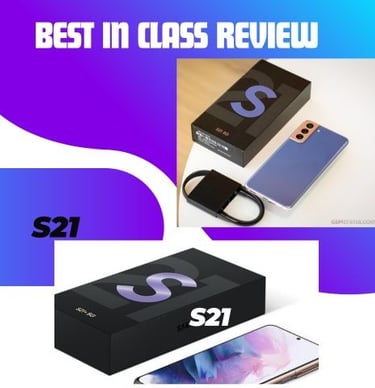

Price Range
Is the Samsung Galaxy S21 Still Worth Buying in 2024?
The Samsung Galaxy S21 is positioned as a premium flagship device, yet it is more affordable than some of its higher-end competitors, such as the Galaxy S21 Ultra and Apple’s iPhone 13 Pro. At launch, the Galaxy S21 started at $799 USD for the base model with 128GB of internal storage, offering a competitive price point for a smartphone of its caliber. The 256GB version typically costs around $849 USD, providing an additional storage option for users who need more space for apps, media, and photos. In comparison to its immediate rivals, the S21 offers a compelling value, especially considering its high-end features like the 120Hz Dynamic AMOLED display, flagship-grade performance, and versatile camera system. While the price of the Galaxy S21 may vary depending on promotions, sales, or trade-in offers, Samsung frequently provides discounts or bundles, making it an attractive option for users looking to get a premium smartphone without breaking the bank. Additionally, Samsung's annual trade-in programs allow customers to offset the price further by exchanging older devices. In many markets, the Galaxy S21 is priced competitively against similar flagship models, such as the Apple iPhone 12 and Google Pixel 6, positioning it as a great value in the premium segment. For those looking for a more budget-friendly alternative, the Galaxy S21 FE (Fan Edition) is expected to offer similar features at a slightly reduced price, making the Galaxy S series accessible to a broader audience.
Evolution from Previous Models
The Samsung Galaxy S21 represents a significant evolution from its predecessors in the Galaxy S series, building on the strengths of earlier models while introducing several exciting improvements. Compared to the Galaxy S20, which was already a standout with its 120Hz display and 5G connectivity, the Galaxy S21 refines the design and performance for an even more streamlined experience. One of the most noticeable changes is the shift to a more compact, sleek design with a plastic back (instead of the glass rear panel on the S20), which reduces weight and improves durability without sacrificing the premium feel. While the Galaxy S20 had a 120Hz display, the S21’s Dynamic AMOLED 2X offers a brighter and more power-efficient screen, enhancing outdoor visibility and battery life.
The camera system has also evolved—though both the S20 and S21 feature triple-camera setups, the S21’s 64MP telephoto lens and enhanced image processing software deliver sharper and more vibrant photos, especially in low light, thanks to improvements in sensor technology and AI-powered enhancements. Another key upgrade is the performance. The Exynos 2100 (or Snapdragon 888 in some regions) chipset in the S21 offers a significant leap in speed, efficiency, and gaming performance compared to the S20’s Exynos 990/Snapdragon 865. Plus, with 8GB of RAM standard across all models, multitasking and app switching is even smoother than before.
Pricing also saw a shift. Samsung made the S21 more affordable than the S20, cutting down on the entry-level cost by offering a more competitive base price without compromising on essential features, making it a better value proposition for consumers who want flagship performance without the premium price tag of the S20 Ultra or iPhone 12 Pro. In short, the Galaxy S21 takes the lessons learned from the S20 and refines them into a more polished, efficient, and cost-effective flagship, making it a great upgrade for those looking for the latest in mobile technology.
Key Decision-Making Factors
When considering whether the Samsung Galaxy S21 is the right phone for you, there are a few key decision-making factors to keep in mind. First, think about your budget—the S21 offers excellent value for its price, with flagship features like a 120Hz display, 5G connectivity, and powerful performance, all at a more affordable rate than some of its competitors. If you're looking for premium design and display quality, the Galaxy S21’s Dynamic AMOLED 2X screen is one of the best in the market, delivering vibrant colors and smooth visuals that make everything from gaming to media consumption a pleasure. Another important factor is camera performance. With its versatile triple-camera setup and enhanced low-light capabilities, the S21 is perfect for users who enjoy photography or want to capture high-quality videos. Additionally, the processor performance is top-notch, so if you’re someone who values speed, multitasking, and gaming performance, the S21’s Exynos 2100 (or Snapdragon 888) chip will easily handle everything you throw at it. However, if you're someone who needs expandable storage or a premium glass build, you might miss those features, as the S21 opts for a plastic back and lacks a microSD card slot. Lastly, consider battery life—while the S21’s 4,000mAh battery gets you through a day of normal use, it’s not the longest-lasting phone, so if heavy usage is a concern, you might want to check other options or take advantage of fast charging features. Ultimately, the S21 is an excellent choice if you're looking for a well-rounded, high-performing smartphone at a competitive price, but these factors will help you decide if it's the right fit for your specific needs.
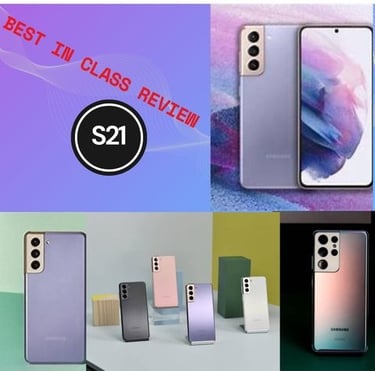

Conclusion
In conclusion, the Samsung Galaxy S21 offers a sophisticated balance of performance, design, and technological innovation that makes it a standout in the crowded premium smartphone market. From a feature perspective, it’s equipped with a stunning Dynamic AMOLED 2X display, delivering exceptional brightness and color accuracy, making it perfect for media consumption and gaming. The device’s powerful Exynos 2100 or Snapdragon 888 (depending on the region) provides fast, responsive performance, ensuring smooth multitasking and gaming experiences. Coupled with its capable camera system, which excels in both low-light conditions and video recording, the Galaxy S21 offers versatile imaging options for all types of users.
The device’s market positioning places it just below the ultra-premium S21 Ultra, making it an attractive choice for those who want flagship-level features without the higher price tag. When compared to competitors like the iPhone 13 and Google Pixel 6, the S21 shines in areas like display quality, 5G support, and a more expansive selection of features at a lower price point. However, it’s not without its compromises—Samsung's decision to omit expandable storage and the removal of the charger from the box might not sit well with everyone.
From an evolutionary standpoint, the Galaxy S21 represents a step forward from its predecessor, the S20, with more refined design choices, faster performance, and a focus on the next-gen 5G technology. The S21's improved camera software and hardware integration also reflect Samsung's continuous refinement of its imaging capabilities, pushing it further ahead of competitors in certain use cases.
When considering its strengths and weaknesses, the S21 excels in performance, display quality, and camera versatility, but it falls short with the lack of microSD support and some may find its battery life not as competitive as some other flagship models. The price range of the Galaxy S21 positions it as an excellent value for those looking for premium specifications without the premium price tag of the S21 Ultra or iPhone 13 Pro Max. Ultimately, the S21 is a great choice for anyone seeking a top-tier Android smartphone that delivers cutting-edge technology, without breaking the bank—perfect for those upgrading from previous models or entering the premium smartphone market for the first time.
In-depth analysis of products across categories.
Contact us info@bestinclassreview.com
© 2024. All rights reserved.
Subscribe for Latest Tech
Article News & Reviews
📬 Stay Ahead with the Latest Tech Article News & Reviews!
If you found this review helpful and want to stay informed about the latest features, security updates, tech article news, and smart insights, don’t miss out on what’s coming next.
👉 Subscribe now to get fresh reviews, breaking tech news, in-depth tech articles, and expert analysis delivered straight to your inbox.
Be the first to know—because staying informed means staying secure.
🔔 Subscribe Here
Your smarter tech journey starts today!
